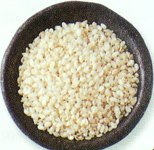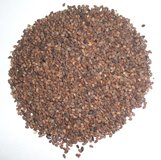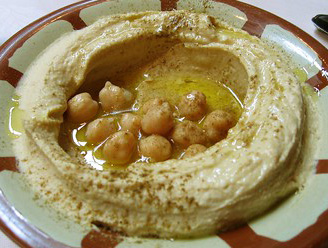Sesame Seeds Nutrition facts
Sesame seeds, among the earliest oil seeds known to humans, have long been utilized both in culinary practices and traditional medicine for their nutritional, preventive, and healing qualities. Rich in phytonutrients like omega-6 fatty acids, flavonoid phenolic antioxidants, vitamins, and dietary fiber, sesame offers potential anti-cancer and health-enhancing benefits.
The sesame plant, belonging to the Pedaliaceae family, is a tall annual herb predominantly found in Asia, particularly in regions such as Burma, China, and India. It also serves as a major commercial crop in countries like Nigeria, Sudan, and Ethiopia,
Scientific name: Sesamum indicum.

|
 |
| White sesame in a bowl. | Brown and black sesame seeds. |
The sesame plant thrives in well-drained sandy soil within a tropical climate. Reaching heights of about 5 feet, it adorns itself with abundant pink-white foxglove-like flowers. Shortly after, pods emerge, carrying white, brown, or black seeds, depending on the cultivar. These seeds are neatly arranged in vertical rows within slender sacs.
Each pod, typically 2-5 cm long, resembles a long rectangular capsule with pronounced grooves along its sides. Some pods, measuring 1 to 2 inches in length, may contain as many as 100 seeds or more.
Sesame seeds themselves are small and nearly flat in shape. When toasted, they impart a delightful, nutty flavor.
Health Benefits of Sesame Seeds
Sesame seeds, known for their flavorful crunch, are widely regarded as healthy foods. With 573 calories per 100 grams, they are rich in essential nutrients, minerals, antioxidants, and vitamins, despite their high fat content.
These seeds boast a significant amount of oleic acid, a mono-unsaturated fatty acid, constituting up to 50% of their fatty acids. Oleic acid aids in reducing LDL ("bad cholesterol") levels and increasing HDL ("good cholesterol") levels, potentially preventing coronary artery disease and stroke, as supported by research on the Mediterranean diet.
Additionally, sesame seeds are valuable sources of dietary protein, containing high-quality amino acids crucial for growth, particularly in children. Just 100 grams of seeds provide approximately 18 grams of protein, fulfilling 32% of daily recommended values.
These seeds contain various health-promoting compounds such as sesamol, sesaminol, furyl-methanthiol, guaiacol, phenyl ethanthiol, furaneol, vinyl guacol, and decadienal. Sesamol and sesaminol act as phenolic antioxidants, collectively combating harmful free radicals in the body.
Sesame seeds are rich in essential vitamins and minerals, particularly B-complex vitamins like niacin, folic acid, thiamin (vitamin B1), pyridoxine (vitamin B6), and riboflavin.
A 100-gram serving of sesame seeds contains 97 µg of folic acid, meeting 25% of the recommended daily intake. Folic acid plays a crucial role in DNA synthesis and may prevent neural tube defects in newborns when consumed by expectant mothers during the peri-conception period.
Niacin, another B-complex vitamin abundant in sesame, provides approximately 4.5 mg or 28% of the daily required levels in a 100-gram serving. Niacin aids in lowering LDL-cholesterol levels and enhances GABA activity in the brain, potentially reducing anxiety and neurosis.
Sesame seeds are exceptionally rich in essential minerals such as calcium, iron, manganese, zinc, magnesium, selenium, and copper. These minerals play vital roles in bone mineralization, red blood cell production, enzyme synthesis, hormone production, and the regulation of cardiac and skeletal muscle activities.
Consuming just a handful of sesame seeds per day can provide recommended levels of phenolic antioxidants, minerals, vitamins, and protein.
| Principle | Nutrient Value | Percent of RDA |
|---|---|---|
| Energy | 573 Kcal | 29% |
| Carbohydrates | 23.45 g | 18% |
| Protein | 17.73 g | 32% |
| Total Fat | 49.67 g | 166% |
| Cholesterol | 0 mg | 0% |
| Dietary Fiber | 11.8 g | 31% |
| Vitamins | ||
| Folates | 97 µg | 25% |
| Niacin | 4.515 mg | 28% |
| Pantothenic acid | 0.050 mg | 1% |
| Pyridoxine | 0.790 mg | 61% |
| Riboflavin | 0.247 mg | 19% |
| Thiamin | 0.791 mg | 66% |
| Vitamin A | 9 IU | <1% |
| Vitamin C | 0 | 0% |
| Vitamin E | 0.25 mg | 2% |
| Electrolytes | ||
| Sodium | 11 mg | 1% |
| Potassium | 468 mg | 10% |
| Minerals | ||
| Calcium | 975 mg | 98% |
| Copper | 4.082 mg | 453% |
| Iron | 14.55 mg | 182% |
| Magnesium | 351 mg | 88% |
| Manganese | 2.460 mg | 107% |
| Phosphorus | 629 mg | 90% |
| Selenium | 34.4 µg | 62.5% |
| Zinc | 7.75 mg | 70% |
| Phyto-nutrients | ||
| Carotene-ß | 5 µg | -- |
| Crypto-xanthin-ß | 0 µg | -- |
| Lutein-zeaxanthin | 0 µg | -- |
Selection and Storage
Sesame seeds are easily found in spice stores year-round, available in various forms: whole, husked, or air-dried, including toasted varieties. They come in black, brown, yellow, or white colors, either packaged in air-sealed packs or sold in bulk bins. The hulled seeds are typically white in appearance.
These seeds contain significant amounts of unsaturated fats, making proper storage essential to prevent them from becoming rancid. It's advisable to keep them in airtight containers in a cool, dark location at home. When stored correctly, dry seeds can remain fresh for several months. However, hulled "white" seeds should always be stored in the refrigerator.
It is important to avoid using old or rancid seeds, which can be identified by their unpleasant odor.
Culinary Uses
Sesame seeds offer a subtle, nutty taste that intensifies when lightly toasted over low heat for a brief period.
In culinary practices, sesame seeds are widely employed. They are blended with olive oil or various vegetable oils to create a rich, semi-solid paste, enhancing the flavor profile of various dishes.
Here are some serving tips:
 |
| Popular Middle Eastern dip-Hummus. Dennis Sylvester Hurd |
Dry, toasted sesame seeds and vegetable oil combined into a thin, light brown paste known as tahini. Tahini serves as a key ingredient in the renowned Middle Eastern dip, hummus.
Sprinkle toasted sesame seeds atop sandwiches, biscuits, bread, cakes, salads, and stir-fries to enhance flavor.
Sesame is widely utilized in Europe for the production of margarine.
Referred to as "til" (तिल ) in India and Pakistan, these seeds are integral to many traditional Indian sweet delicacies, often blended with roasted peanuts, almonds, and jaggery.
Toasted and crushed sesame frequently used as garnish salads, desserts, especially sundaes, and various confectionery preparations.
Gomashio (toasted sesame salt-(ごま塩)) represents a Japanese specialty, incorporating ground sesame seeds.
Sesame oil derived from these seeds ranks among the most coveted cooking oils in Malaysia, Indonesia, and the southern regions of rural India.
Safety profile
Sesame seeds allergy manifests as a hypersensitivity reaction in susceptible individuals, leading to symptoms such as hives, dermatitis, and itching. In severe cases, symptoms may escalate to include vomiting, stomach pain, and swelling of the lips and throat, resulting in breathing difficulties, chest congestion, and potentially fatal outcomes. Consequently, it is advisable for individuals with this allergy to avoid consuming sesame products. (Please refer to our Medical Disclaimer.)
≺≺ Back to Nuts and seeds from Sesame Seeds. Visit here for an impressive list of nuts with complete illustrations of their nutrition facts and health benefits.
≺≺ Back to Home page.
Further Resources:
Stanford School of Medicine Cancer information Page- Nutrition to Reduce Cancer Risk.
Nutritional, Medicinal and Industrial Uses of Sesame (Sesamum indicum L.) -PDF.